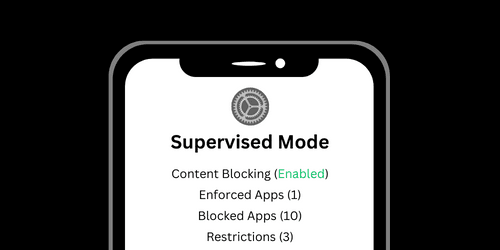Content Filtering
How to Enforce a Content Filter on an iPhone
There are many different ways that a content filter can be effectively enforced on iPhones or iPads.
If you have configured content filtering on your iPhone, you've probably realized that there are numerous loopholes that allow a user to bypass filtering entirely. If you are focused on blocking addictive web content, then you also need to prioritize protecting content filtering on the iPhone so that it isn't bypassed (either intentionally or accidentally) via an app or some other means. There are effective ways to protect content filtering, even for adults.
Since traditional approaches for effectively enforcing a content filter on an iPhone are usually easy to disable, you may need to consider a more comprehensive blocking system instead. This blocking system uses multiple approaches at once, meaning that you don't need to rely on a single point of failure.
Enforcing a content filter is an important step if you're creating a comprehensive blocking system that blocks adult content on iPhone .
Choosing an Approach for Protecting Content Filtering
We're using a special approach in this guide that you've probably never heard of - here's why.
If you are using network settings (DNS or VPN settings) to connect to a content filtering service that blocks websites on your iPhone, this connection cannot be adequately protected on a standard iPhone.
You are limited to the built-in content filtering feature provided by Screen Time. This is also true if you download an app from the App Store, because they often leverage Screen Time's filter behind the scenes. Since these apps rely on Screen Time, they can be easily disabled by using the Settings app on your iPhone, and you won't be able to enforce your settings with a PIN like you could with Screen Time.
Furthermore, if Screen Time is being configured for an adult, the adult can easily bypass Screen Time settings even if a passcode is set.
As a result, I always recommend using a more advanced option that is available on most iPhone or iPad devices. Since I've spent a significant amount of time researching advanced techniques and restrictions for iPhone devices, I'll explain what exactly that means.
Enable Supervised Mode for Advanced Content Filtering Protection
Apple provides an alternative to Screen Time , called supervised mode, which can be used to effectively protect content filtering on an iPhone, even for adults who want to filter web content for themselves.
Supervised Mode works a bit differently when compared to Screen Time: instead of adding apps or configuring settings on the iPhone device itself, you install Config Files that protect these settings.
You're able to customize your own Config Files using an Apple Config Generator , then install these Config Files onto your iPhone to apply changes. They're perfect if you're managing your own iPhone, since to remove these restrictions, the Config Files need to be removed, and you can set things up such that outside help is required to do this.
Plus, Config Files can properly protect the VPN or DNS settings needed for most services by disabling common features used to bypass content filtering on your iPhone. Even better, you can prevent filtered VPN or DNS settings from being removed by installed protected versions of those settings.

Enforce a Filtered VPN
Content filters can use different approaches or techniques to block websites and apps, but the most common way is by using an app that adds a VPN configuration to your iPhone.
As a result, it's important to ensure that this filtered VPN can't be disabled, removed, or bypassed. There are a few ways that you could enforce this on a standard iPhone, but supervised iPhones have more options that are significantly more difficult to undo later.
There are several different options that you might consider, so see our dedicated guide for enforcing VPNs on iPhone for full instructions.
Block Conflicting VPNs
VPNs tend not to mix well with content filters, and a VPN's network settings will likely override other network settings on your iPhone.
Even worse, if your content filter uses a VPN, you're limited to using one VPN at a time. Since you can't chain VPN connections, switching to a non-filtered VPN needs to be prevented.
Fortunately, there are several ways that you can effectively block VPNs on iPhones , and depending on how strict of a setup you need, it's possible to:
- Completely prevent new VPNs from being added by an app or manually through settings
- Restrict VPN or "privacy" browsers from being added to the iPhone
Enforcing Apple's Adult Content Filter
Apple provides a built-in content filter that lets you block websites and filter adult content automatically. You can force this filter and prevent it from being disabled, and choose to block websites on iPhone in a few different ways.
Similar to the options you might consider if you're enforcing a filtered VPN, you might have different options to consider depending on whether your iPhone is supervised or not.
If supervised mode is enabled on your iPhone and you use our Apple Config Generator , you can toggle on "Enable Automatic Adult Content Filter" like this:
This will lock on and protect Apple's automatic adult content filter.
Then, you can customize your own list of extra websites that you want to block:
Since these settings are managed by a config file, you don't have to worry about websites being unblocked or adult content filtering being turned off.
Adding Fallback DNS Settings
Another area to consider is to add backup DNS settings on your iPhone that cannot be deleted by the user. This ensures that if your content filtering VPN is bypassed for some reason, the iPhone's connection will fall back to DNS settings and continue to filter content as if the content filtering VPN were still active.
If you've enabled Supervised Mode on your iPhone, you can install a protected DNS config to ensure that DNS settings can't be modified: